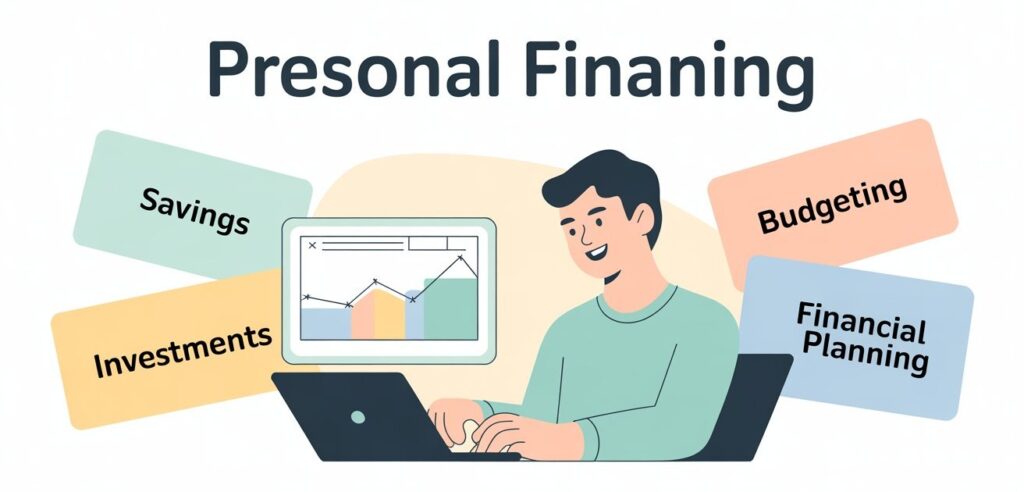Managing personal finances is a crucial skill that empowers individuals to make informed decisions about budgeting, saving, investing, and planning for the future. This guide aims to provide foundational knowledge on personal finance, helping you understand key concepts and take control of your financial well-being.
What IS personal finance?
Personal Finance refers to the management of an individual’s or a family’s financial activities, including earning, spending, saving, investing, and protecting money over time. The goal is to make informed financial decisions that help you achieve your short-term needs and long-term financial goals, such as buying a house, saving for retirement, or becoming debt-free.
Here’s a detailed breakdown of its key components:
1. Income
This is the money you earn from various sources like a job (salary), business, freelance work, rental income, dividends, etc.
Managing income involves knowing how much you earn and ensuring it covers your expenses, savings, and investments.
2. Budgeting
Budgeting is planning how you will spend your income.
A common method is the 50/30/20
rule:
50% for needs (rent, bills, food)
30% for wants (entertainment, shopping)
20% for savings and debt repayment
3. Expenses
These are the costs for daily living and lifestyle.
There are two types:
Fixed expenses: Rent, EMI, insurance premiums
Variable expenses: Food, travel, shopping
Tracking your expenses helps you avoid overspending and identify areas to cut costs.
4. Saving
Saving means setting aside a portion of your income for future use or emergencies.
Key savings goals include:
✓ Emergency fund (3–6 months of expenses)
✓ Big purchases (vacation, car)
✓ Retirement savings
5. Investing
Investing helps grow your money over time through avenues like:
Stocks, mutual funds, real estate, bonds, gold, etc.
Investing involves risk, but it’s essential for wealth building and beating inflation.
6. Debt Management
Includes loans, credit cards, and EMIs.
Good personal finance means using debt wisely and avoiding high-interest loans or unnecessary borrowing.
7. Insurance & Risk Management
Insurance protects you from unexpected financial losses.
Examples: Health insurance, life insurance, car insurance
It’s a key part of financial planning to reduce risk.
8. Retirement Planning
Planning your finances to ensure a comfortable life after you stop working.
Includes investing in retirement funds like PPF, NPS, EPF, or pension plans.
9. Tax Planning
Legal ways to reduce your tax liability through deductions, exemptions, and investments under sections like 80C, 80D, etc.
10. Estate Planning
Planning how your assets will be distributed after your death.
Includes writing a will, setting up nominees, and legal documentation to avoid future disputes.
Managing personal finance effectively means taking smart, intentional steps with your money so that you can meet your needs today, prepare for emergencies, and achieve long-term goals like buying a home or retiring.
Here’s a step-by-step guide to manage your personal finances:
Step-by-Step Personal Finance Management
Step 1: Track Your Income and Expenses
Know exactly how much you earn monthly (salary, freelance, passive income).
Track every rupee you spend for at least one month using an app or Excel.
click the link below to download our App:-
Understand your spending pattern — where is your money going?
Step 2: Create a Monthly Budget
Use the 50/30/20 Rule or make a custom plan:
50%: Needs (rent, bills, groceries)
30%: Wants (eating out, shopping)
20%: Savings, investing, debt repayment
Stick to your budget and adjust monthly based on your goals.
Step 3: Build an Emergency Fund
Save at least 3–6 months of living expenses in a separate account.
Use it only for real emergencies (job loss, medical issues, etc.).
Step 4: Clear High-Interest Debt
Pay off credit card dues or personal loans with high interest first.
Use methods like:
Debt Snowball (start with smallest loan)
Debt Avalanche (start with highest interest)
Step 5: Start Saving and Investing
Begin with safe investments like:
Recurring/Fixed Deposits
Public Provident Fund (PPF)
Gradually invest in:
Mutual Funds (via SIPs)
Stocks or ETFs (if you understand markets)
Start early — compounding works best over time.
Step 6: Get Proper Insurance
Health insurance for yourself and family
Life insurance (preferably term insurance) if you have dependents
Avoid unnecessary policies (like endowment plans)
Step 7: Set Financial Goals
Set clear, measurable goals like:
Buy a house in 5 years
Save ₹10 lakhs for retirement
Take a family vacation next year Then plan your savings/investments accordingly.
Step 8: Plan for Retirement
Start early, even if with a small amount.
Use NPS, PPF, EPF, or retirement mutual funds.
Calculate how much you’ll need after retirement.
Step 9: Do Tax Planning
Use deductions under Section 80C, 80D, etc.
Invest in tax-saving instruments like ELSS, PPF, NPS, insurance.
Step 10: Review & Adjust Monthly
Every month, review your:
Budget
Expenses
Savings/investments
Adjust based on your life changes and income growth.
Take a Quick Personal Finance Self-Test!
Want to check how much you’ve learned?
[Click here to take the Personal Finance Quiz]
— it takes just 2 minutes!
Conclusion
Personal finance is not difficult to understand, but it requires commitment and a step-by-step approach. Start by setting goals, budgeting, saving, and investing. Slowly but surely, you’ll be able to take control of your finances and build a secure future.
